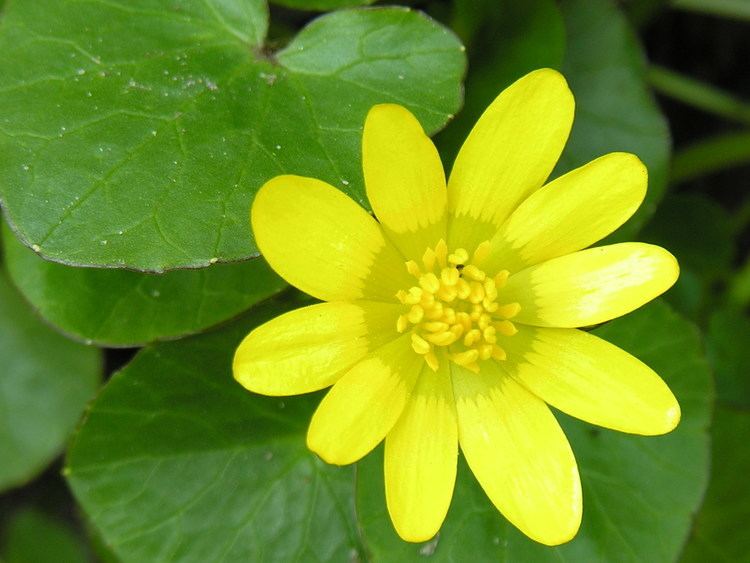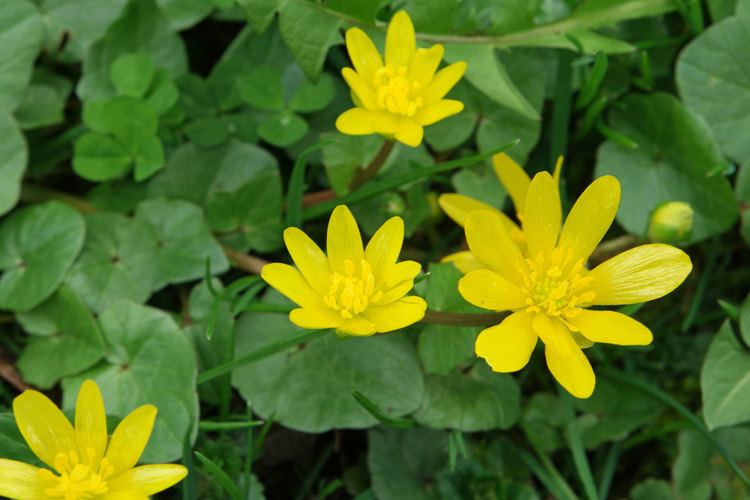Rank Species | Genus Ficaria Higher classification Buttercup | |
 | ||
Similar Marsh Marigold, Meadow buttercup, Garlic mustard, Cuckoo Flower, Cowslip | ||
Citizen science the invasive fig buttercup ficaria verna
Ficaria verna, (formerly Ranunculus ficaria L.) commonly known as lesser celandine, is a low-growing, hairless perennial flowering plant in the buttercup family Ranunculaceae native to Europe and west Asia. It has fleshy dark green, heart-shaped leaves and distinctive flowers with bright yellow, glossy petals. It is now introduced in North America, where it is known by the common name fig buttercup and considered an invasive species. The plant is poisonous if ingested raw and potentially fatal to grazing animals and livestock such as horses, cattle, and sheep. For these reasons, several US states have banned the plant or listed it as a Noxious weed. It prefers bare, damp ground and is considered by horticulturalists in the United Kingdom as a persistent garden weed. Emerging in late winter with flowers appearing March through May, its appearance across the landscape is regarded by many as a harbinger of spring.
Contents
- Citizen science the invasive fig buttercup ficaria verna
- Description
- Distribution
- Life cycle
- Ecology as an invasive species
- Toxicity
- Treatment
- Historical herbal use
- References

Description

Lesser celandine is a hairless perennial, with spirally-arranged cordate dark-green leaves without stipules. It produces actinomorphic (radially symmetrical) flowers with 3 sepaloid tepals and 7-12 glossy yellow petaloid tepals. Double flowered varieties also occur. The stamens and carpels are numerous, and the fruit is a single-seeded achene with a very short style. In several sub-species, tubers are formed in the leaf axils after flowering.
Distribution

Ficaria verna sensu lato is native to central Europe, north Africa and the Caucasus. It is not native in North America.
Life cycle

Lesser celandine grows on land that is seasonally wet or flooded, especially in sandy soils, but is not found in permanently waterlogged sites. In both shaded woodlands and open areas, Ficaria verna begins growth in the winter when temperatures are low and days are short. The plants mostly propagate and spread vegetatively, although some subspecies are capable of producing up to 73 seeds per flower. Germination of seeds begins in the spring, and continues into summer. Seedlings remain small for their first year, producing only one or two leaves until the second year.
Growth and reproduction is poor in dry or acidic conditions, though the plants can handle drought well once dormant. By emerging before the forest canopy leafs out, Ficaria verna is able to take advantage of the higher levels of sunlight reaching the forest floor during late winter and early spring. By late spring, second year plants quickly age as daylight hours lengthen and temperatures rise. By the end of May, foliage has died back and plants enter a six month dormancy phase.
If disturbed, separation of the plant's numerous basal tubers is an efficient means of vegetative propagation. The plants are easily spread if the prolific tubers are unearthed and scattered by digging activities of some animals and humans. Erosion and flood events are particularly effective means of spread, as the plants are very successful at colonizing low-lying floodplains once deposited.
Ficaria verna exists in both diploid (2n=16) and tetraploid (2n=32) forms which are very similar in appearance. However, the tetraploid types prefer more shady locations and can develop up to 24 bulbils at the base of the stalk. Subspecies F. verna bulbilifera, F. verna chrysocephalus, and F. verna ficariiformis are tetraploid and capable of colonizing new areas much faster because of bulbil production. Subspecies F. verna calthifolia and F. verna verna are diploid and hybrids between subspecies often create sterile triploid forms.
Ecology as an invasive species
In many parts of the Eastern and Northwestern United States and Canada, lesser celandine is cited as an invasive species. It poses a threat to native wildflowers, especially those ephemeral flowers with a spring-flowering lifecycle. Since Ficaria verna emerges well before most native species, it has a developmental advantage which allows it to establish and dominate natural areas rapidly. It is mainly a problem in forested floodplains, where it forms extensive mats, but can occur on upland sites as well. Once established, native plants are displaced and ground is left barren and susceptible to erosion, from June to February, during the plant's six-month dormancy phase.
In the United States, where lesser celandine is considered a plant pest to gardens, lawns, and natural areas, many governmental agencies have made great effort attempting to slow the spread of this species with limited success. As of 2014, the species was reported to be invasive and established in 25 states. USDA APHIS considers Ficaria verna to be a high risk weed which could spread across 79 percent of the United States, anticipating possible impacts to Threatened and Endangered riparian species. The U.S. National Park Service's Plant Conservation Alliance recommends avoiding planting lesser celandine, and instead planting native ephemeral wildflowers such as Asarum canadense, bloodroot, the native twinleaf (Jeffersonia diphylla), and various species of trillium as alternatives.
Toxicity
All plants of the buttercup family (Ranunculaceae) contain a compound known as Protoanemonin When the plant is wounded, the unstable glucoside ranunculin turns into the toxin Protoanemonin. Contact with damaged or crushed Ficaria leaves can cause itching, rashes or blistering on the skin or mucosa. Ingesting the toxin can cause nausea, vomiting, dizziness, spasms, or paralysis. In one case, a patient experienced acute hepatitis and jaundice when taking untreated lesser celandine extracts internally as an herbal remedy for hemorrhoids.
Treatment
It has been documented that through drying of these plants, the protoanemonin toxin dimerizes to non-toxic anemonin, which is further hydrolyzed to non-toxic carboxylic acid. Cooking of the plants is also documented to eliminate the toxicity of the plants and records show the plant has been incorporated in diets or herbal medicine after being dried, and ground for flour, or boiled and consumed as a vegetable.
Historical herbal use
The plant is known as pilewort by some herbalists because it has historically been used to treat piles (hemorrhoids). Lesser celandine is still recommended in several "current" herbal guides for treatment of hemorrhoids by applying an ointment of raw leaves as a cream or lanolin to the affected area. Supposedly, the knobby tubers of the plant resemble piles, and according to the doctrine of signatures this resemblance suggests that pilewort could be used to cure piles.
The German vernacular skorbutkraut ("scurvy herb") derives from the use of young leaves, which are high in vitamin C, to prevent scurvy. However, use of lesser celandine to prevent scurvy could be considered a misnomer, tied to its similar appearance to common scurvygrass (Cochlearia officinalis), which shares similarly shaped leaves as well as sharing the german name skorbutkraut. The German Hager's Manual of pharmacy practice of 1900 states Ranunculus ficaria [sic] and C. officinalis both share this name and use, though there was little documentation of the toxicity of untreated Ficaria species at the time.
Most guides today point out that medicines should be made from the dried herb or by heat extraction as the untreated plants and extracts will contain protoanemonin, a mild toxin. The plant has been widely used in Russia and is sold in most pharmacies as a dried herb. The protoanemonin found in fresh leaves is an irritant and mildly toxic but is suggested to have antibacterial properties if used externally. The process of heating or drying turns the Ranunculaceae toxin to anemonin which is non-toxic and may have antispasmodic and analgesic properties.
